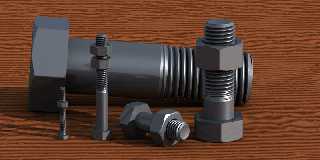|
 |
i changed the shamfered thread into a smooth parabole.
the thread ege is now also higlighted.
also rounded some of the edges of the boldheads and nuts.
I realized that using many functions in min( , ) and max( , )
will result in eash finction being calculated, and then only one will be
used.
I added 2 levels of select(z-.., f_a, f_b) to split the function into the
4 parts but this was only 1.5 times faster.
i now have 4 seperate iso surfaces, witch seems to be mutch faster, and
i can also lower the max_gradient and accuracy for parts that are mostly
flat.
#macro thread_macro( thrOD, totalLen, solidLen, thrSpoed )
// thrOD : outer diameter, before "cutting" the thread.
// totalLen: result: <0,0,0> to <0,0,-totalLen>
// solidLen: <0,0,0> to <0,0,-solidLen> is not threaded.
// thrSpoed: displacement per revolution (spoed) (=25.4/tpi)
#local thrAngle = 60; // (degrees)
#local chamOut = 0.00; // chamfer outside (part of threadDepts)
#local thrRad = 0.5*thrOD;
#local thrs = 1/thrSpoed;
#local thrDepts = 0.5*thrSpoed/tan(radians(thrAngle)*0.5);
#local f_rev = function{ atan2(x,y)/(pi*2) } // 0..1
#local f_thread_a = function{ abs(mod(2+(z*thrs+f_rev(x,y,z))*2,2)-1) }
// 0..1
#local f_thread_b = function{ pow(f_thread_a(x,y,z),2) }
#local f_thread = function{ f_thread_b(x,y,z) }
#local f_threadCha = function{ thrDepts*max(chamOut,f_thread(x,y,z)) }
#local f_solidCone = function{ (z-solidLen)*0.25 } // cone between solid
and thread
#local f_endCone = function{ thrDepts+z-totalLen } // cone at end of
bold
#local f_dimple = function{
2*thrOD-sqrt(pow(x,2)+pow(y,2)+pow(totalLen+thrOD*1.965-z,2))}
#local f_rad_A = function{ thrRad
}
#local f_rad_B = function{
thrRad-min(f_threadCha(x,y,z),f_solidCone(x,y,z))}
#local f_rad_C = function{ thrRad- f_threadCha(x,y,z)
}
#local f_rad_D = function{
thrRad-max(f_threadCha(x,y,z),f_endCone(x,y,z)) }
// part_A // solid
// part_B // cone: between sollid and thread
// part_C // thread
// part_D // thread at end of bolt, with dimple
#local f_part_A = function{ sqrt(pow(x,2)+pow(y,2))-f_rad_A(x,y,z)}
#local f_part_B = function{ sqrt(pow(x,2)+pow(y,2))-f_rad_B(x,y,z)}
#local f_part_C = function{ sqrt(pow(x,2)+pow(y,2))-f_rad_C(x,y,z)}
#local f_part_D =
function{max(sqrt(pow(x,2)+pow(y,2))-f_rad_D(x,y,z),f_dimple(x,y,z))}
// select one of the 4 parts: (and only use the functions needed for THAT
part!)
/*
#local f_part_AB = function{ select(z-solidLen, f_part_A
(x,y,z), f_part_B (x,y,z))}
#local f_part_CD = function{ select(z-totalLen+thrDepts, f_part_C
(x,y,z), f_part_D (x,y,z))}
#local f_final = function{ select(z-solidLen-thrDepts/0.25,
f_part_AB(x,y,z), f_part_CD(x,y,z))}
*/
isosurface {
function{ f_part_A(x,y,z) }
max_gradient 2.0
accuracy thrOD/500
contained_by{box{<-thrRad,-thrRad,0>,<thrRad,thrRad,solidLen>}}
scale <1,1,-1>
}
isosurface {
function{ f_part_B(x,y,z) }
max_gradient 2.0
accuracy thrOD/500
contained_by{box{<-thrRad,-thrRad,solidLen>,<thrRad,thrRad,solidLen+thrDepts/0.25>}}
scale <1,1,-1>
}
isosurface {
function{ f_part_C(x,y,z) }
max_gradient 2.0
accuracy thrOD/500
contained_by{box{<-thrRad,-thrRad,solidLen+thrDepts/0.25>,<thrRad,thrRad,totalLen-thrDepts>}}
scale <1,1,-1>
}
isosurface {
function{ f_part_D(x,y,z) }
max_gradient 2.0
accuracy thrOD/500
contained_by{box{<-thrRad,-thrRad,totalLen-thrDepts>,<thrRad,thrRad,totalLen>}}
scale <1,1,-1>
}
#end
jaap.
Post a reply to this message
Attachments:
Download 'parts5.jpg' (73 KB)
Preview of image 'parts5.jpg'

|
 |




![]()